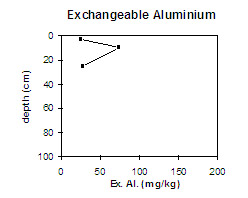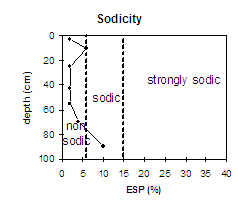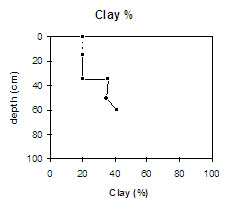NE33
| Property: Rutherglen Research Institute | Paddock #: E |
| Aust. Soil Class.: Bleached-Sodic, Eutrophic, Yellow DERMOSOL | Northcote Factual Key: Gn 4.65 |
| Great Soil Group: yellow soloth | Map Unit: Rutherglen loam (deep phase). |
| General Landscape Description: Slightly lower lying area of plain. |
Soil Profile Morphology:
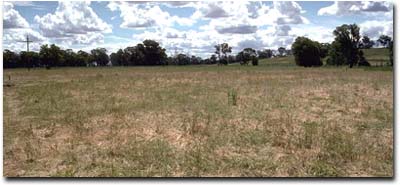
NE33 Landscape
Surface Soil
| A11 | 0-5 cm | Yellowish brown (10YR5/4); fine sandy clay loam; weak coarse blocky structure; pH 5.5; clear change to: | 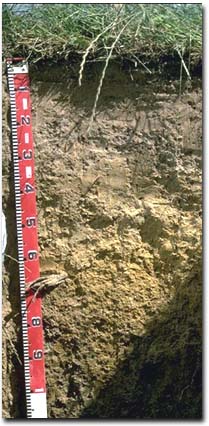 NE33 Profile |
| A12 | 5-15 cm | Yellowish brown (10YR5/4); silty clay loam; pH 4.9; abrupt change to: | |
| A2 | 15-35 cm | Light yellowish brown (10YR6/4) conspicuously bleached (10YR8/2d); fine sandy clay loam; weak coarse blocky structure; contains a few (10%) ferromanganiferous nodules (2-10 mm size); pH 5.2; clear and wavy change to: | |
| Subsoil | |||
| B21 | 35-50 cm | Very pale brown (10YR7/4) with yellow (10YR7/8) mottles; light clay (fine sandy); weak medium blocky structure; strong consistence dry; contains a few (2-5%) ferruginous concretions (10 mm size); pH 5.9; abrupt change to: | |
| B22 | 50-60 cm | Yellow (10YR7/8); light clay (fine sandy); weak to moderate medium blocky structure; pH 6.0; clear change to: | |
| B23 | 60-80 cm | Brownish yellow (10YR6/6 and 6/8); medium clay; moderate medium blocky structure; pH 5.8; clear change to: | |
| B3 | 80+ cm | Light brownish grey (10YR6/2) with yellowish brown (10YR5/6 and 5/8) mottles; medium heavy clay; moderate medium blocky structure; contains a few (5-10%) ferromanganiferous nodules (6-10 mm size); pH 6.6. | |
Key Profile Features:
- Lack of strong texture contrast between surface (A) horizon and subsoil (B21) horizon.
- Conspicuously bleached subsurface (A2) horizon.
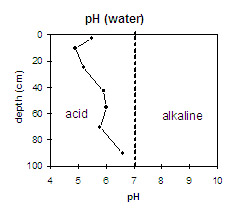 | The surface horizons are strongly acid. The upper subsoil is moderately acid and the deep subsoil becomes slightly acid. | 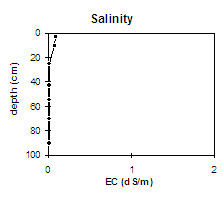 | Soluble salt levels are very low throughout the profile. |
| Exchangeable aluminium levels increase in the very strongly acid A12 horizon and decrease as pH levels increase. |
| The upper soil profile is non-sodic (and non-dispersive) throughout. The deep subsoil (from 80 cm depth) becomes sodic |
| There is a moderate texture contrast at the A/B horizon boundary. |
Management Considerations:
Whole Profile
- Plant available water capacity (PAWC) is considered to be low (estimated at 85 mm) for the top metre of the soil profile. This is based on available laboratory data.
- The hardsetting surface soil has a high fine sand and silt content (ie. 78%). Organic matter is therefore important for maintaining aggregation and prevent slaking. Tillage should be minimised and stubble retention/pasture rotation practised to build up organic matter levels if cropping takes place.
- The strongly acid surface soil indicates that aluminium and manganese toxicity may occur. Exchangeable aluminium levels are highest in the very strongly acid subsurface (A12) horizon (ie. 74 ug/g). These levels may affect highly aluminium sensitive species (eg. lucerne, phalaris, barley, some wheat varieties). Exchangeable aluminium levels decrease in the A2 horizon as pH increases.
- The nutrient status (based on the sum of the exchangeable basic cations) of the surface horizons is very low.
- The upper subsoil should be relatively well drained, being non-sodic and having calcium as the dominant exchangeable cation. The lower subsoil (from 80 cm depth) is sodic (and has a low exchangeable calcium:magnesium ratio) and disperses strongly which will result in restricted deep drainage.
- The nutrient status (based on the sum of the exchangeable basic cations) of the upper subsoil is relatively low.
- Ploughed (1970)
- Trikkala clover sown 1990.

